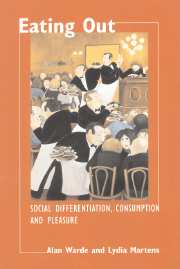Book contents
Methodological appendix: data collection and analysis
Published online by Cambridge University Press: 22 September 2009
Summary
The semi-structured interviews were conducted first because it was thought that in the absence of prior social scientific inquiry it would otherwise be difficult to construct informative questions for a survey instrument. For example, we were not sure whether people would be able to recall details of what they had eaten on their most recent excursions, something about which we were much reassured in the course of the interviews. Nor were we entirely confident that the themes and trends discussed in the popular media would intersect, never mind resonate, with the generality of ordinary experience. Thus, in the absence of previous scholarly investigation, we deemed it essential to pay great attention to the experiences and understandings of a cross-section of the population. Hence an accurate empirical description of practices and discourses, and their social distributions, was a major objective.
Semi-structured interviews – with thirty-three principal food provider(s) in thirty households in diverse circumstances living in Preston and the surrounding area, during the autumn of 1994 – each lasted between one and two hours. To ensure variety, interviewees were volunteers contacted through various organisations, a leisure centre, a community association, a tennis club, an environmental group, a primary school, a trade union branch and, finally, a national DIY chain store.
Our sampling was modelled on DeVault (1991), and like her,we sought to speak to ‘anyone, man or woman, who performed a substantial portion of the feeding work in the household’ (22).
- Type
- Chapter
- Information
- Eating OutSocial Differentiation, Consumption and Pleasure, pp. 228 - 233Publisher: Cambridge University PressPrint publication year: 2000



